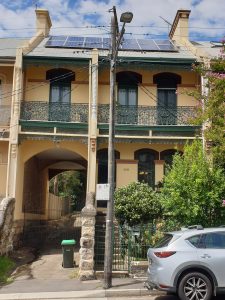By Lyn Collingwood, March 2022, from Bulletin 1/2022

Inspired by reports he heard of the flying exploits of the Wright brothers and lectures he attended given by Lawrence Hargrave, ‘Jack’ Jones built an aeroplane frame and engine in the backyard of his 108 Hereford St house.
With little money and few facilities, he was helped by his older brother William Henry, a photographer. The design was submitted to a Commonwealth military aircraft competition, announced in 1909. The competition lapsed but Jones continued the project, using a treadle lathe to make the parts. The body was made of imported white pine and the propellor of Australian spotted gum.
In 1911, Jones took his dismantled steam-powered aircraft by horse and cart to Emu Plains. Curious trespassers were warned off the paddock where it was reassembled. The craft made a few successful flights before being irreparably damaged in a storm.
In 1912, Jones constructed a lighter machine, also powered by steam. It was wrecked, rebuilt with a petrol engine, but abandoned after further damage.
Jones enlisted in the Australian Flying Corps in 1916, served in France, and in 1919 was discharged in London with the rank of corporal mechanic. He remained in England, working for General Electric and aircraft manufacturers A V Roe. Back in Australia by 1921, he was employed by Edgar Percival at Richmond, and the Aviation Service and Larkin Aircraft Supply companies, before setting up as an aeronautical engineer and consultant. In 1923 he gained his ground engineer’s licence.
Commissioned in 1927 to design and construct an aircraft capable of crossing the Tasman Sea, Jones designed an all-steel welded framework. The machine, containing ‘many strange innovations in the business of aircraft construction’, made successful flight tests before being damaged by a storm and rebuilt. In June 1932 it crashed at Quakers Hill, killing both occupants, an accident which made news headlines.

Jones lectured on aeronautical engineering at East Sydney Technical College and was a foundation member of the Hargrave Institute. He began work on an all-Australian aircraft for the 1934 London to Melbourne Air Race but the entry was abandoned when time and money ran out. During the Second World War he was project engineer with the Department of Aircraft Production and worked on the Mosquito bomber. Postwar he left the aircraft industry, retiring from employment in 1962.
Jones died at Windsor in July 1970, survived by his second wife Olive Marion née Love and their son. (His first marriage to Pretoria Eugesta née Hinchcliffe had ended in divorce in 1936.) He was buried in the Methodist section of the Field of Mars, the resting place of his mother.
Leslie John Roberts Jones was born on 4 June 1886 at Bathurst. His parents were picture frame maker William Henry and Rosina née Dumbrell who in 1876 married at Redfern where William jnr (1877-1952) was born. The birth of a sister Florence was registered at Bathurst in 1881. Jack Jones was educated at Bathurst Superior Public School and worked in his father’s shop before the family moved to Sydney. It was while he was employed as a hospital X-ray operator that he first turned his technical expertise to aeronautical engineering.









There are no comments yet. Please leave yours.